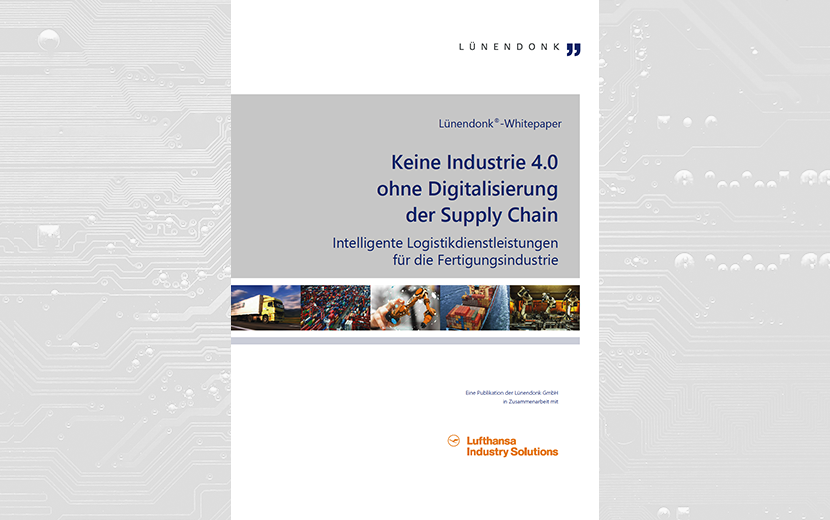Manufacturing stands to benefit more than perhaps any other sector from the opportunities of Industry 4.0. Ideally, making machines and manufacturing processes digitally connected leads to a near-autonomous smart factory. But what happens then? How will supply chains have to change to keep pace with these developments? The Lünendonk® white paper has the answer to this and other pressing questions.
The Lünendonk® white paper “No Industry 4.0 without a digitalized supply chain”
Logistics also has to take the next step
Advancing digitalization is changing production processes – and much more. Logistics companies also have to adapt to the new conditions if they want to continue to be reliable partners to the manufacturing industry. The supply chain from provider to recipient can only work smoothly if crucial data is collected, processed and exchanged using IT systems.
Digitalization also enables the logistics sector to successfully explore new fields of business. Whether it’s working with monitoring systems, using image analysis software or acquiring contracts using online transport exchanges, new fields of application that will enable greater transparency, better planning and more tailored services are plentiful. Companies that do not implement future-ready technologies like these, both in manufacturing and in logistics, will soon find themselves squeezed out of the market by their competitors.
The white paper contains
- explanations of the key elements of a modern supply chain as well as an overview of useful functionalities and components for smart supply chain platforms,
- examples of use that demonstrate the benefits of the new technologies,
- explanations of the opportunities, risks and effects of the digitalization process in the supply chain, and
- tips on the challenges that management will have to tackle.
Read this white paper to learn about the prerequisites for digitalizing your supply chain (only available in German).
The white paper was created by Lünendonk GmbH in collaboration with Lufthansa Industry Solutions.
White paper insights
You can read about all the findings and explanations regarding the opportunities, risks and challenges associated with digitalizing supply chains in the white paper. The white paper is available to download for free (only available in German). Some of the most relevant insights are summarized below.
Businesses are aware of the significance of a digitalized supply chain
Digitalization is an omnipresent topic at most companies. The supply chain, which will be even more indivisibly connected to all production processes in the future than it is today, will also be affected by digitalization. According to a study carried out by GT Nexus, 95 percent of the companies surveyed plan to further automate interaction processes with suppliers, and 94 percent also want to focus more on real-time status updates. That’s a key point when you consider that the location of a product can often only be determined at individual transshipment points today. Transparency needs to be increased. That is why companies want to invest in four key aspects of the supply chain.
These foundational technologies are indispensable
A digital transformation needs certain software solutions and foundational technologies. Although there are always new developments in this regard, some things have become standard and can help when adjusting the supply chain. For example, goods can be monitored using sensors. Particularly when it comes to sensitive products, it is very important to know about every change in storage or delivery conditions. Robotics ensure safety and efficiency when it comes to handling goods. Automation like this can open up new possibilities when it comes to labeling or loading and unloading. You can track your goods’ routes and flexibly make plans using GPS technology.
These risks should not be forgotten
Although there is no alternative to digitalizing the supply chain, it harbors a number of risks. While they should not stop the transformation process, you should be aware of these risks in order to prepare for them. For the manufacturing industry, for example, the inability of previous suppliers to keep pace with new standards can become a problem, increasing the potential for error and, in the worst-case scenario, rendering the various systems incompatible. That makes it all the more important for logistics companies to initiate their own digitalization processes and not stand on the sidelines watching developments in the manufacturing sector pass them by.
The benefits you can expect from a state-of-the-art supply chain
All changes in industry come with their own risks. However, this should not stop you from being up to date in the manufacturing or logistics sector with a state-of-the-art supply chain. You can expect a range of benefits, including increased transparency – which leads to improved planning – as well as minimal bottlenecks and sources of errors, meaning you can offer more tailored services to your customers. Companies see great potential in the following aspects:
You can find details on all findings, statistics and recommendations in the “No Industry 4.0 without a digitalized supply chain” white paper. You can download the free PDF here (only available in German).





